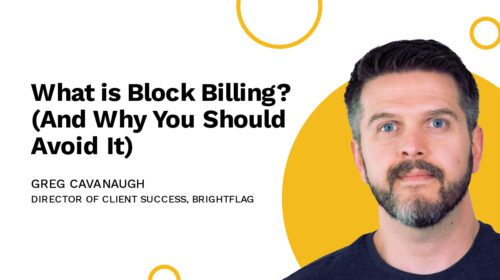When (and How) to Update Outside Counsel Guidelines
Knowing how to update outside counsel guidelines provides in-house legal teams with a realistic opportunity to generate massive results from relatively minimal resources.
Invest a little time in clarifying expectations and you can expect a significant return in the form of expenses avoided, hours saved, and conflicts averted — each month for the life of each law firm relationship.
It’s a plainly great deal.
So while the vast majority of your time investment will go toward creating your first set of billing guidelines, you’ll also need to budget for periodic updates as teams, matters, and priorities naturally evolve.
And although refreshing outside counsel guidelines is the smaller of the two tasks, it still requires a well-considered approach.
Here’s how I encourage corporate legal departments to think through the challenge.
When to Update Outside Counsel Guidelines
Before we discuss expectations for outside counsel, I need to set an important expectation for in-house teams. There will always be a delay between sharing guidelines and changing behaviors.
Both your outside counsel and your internal invoice reviewers need time to get up to speed with the new guidelines and adjust their processes accordingly. This is all perfectly normal — and it’s why I personally advise Brightflag customers to build a grace period into their billing guideline rollouts.
The ideal breakdown is as-follows:
Months 1–2
The first few months after rolling out your outside counsel guidelines offer an opportunity to monitor compliance. It’s also a great chance to solicit feedback in a relatively low-pressure environment.
Month 3
After the first three months of familiarization and feedback, it’s time to put policy into practice. Now is when you should start adjusting invoices that have clear outside counsel guideline breaches.
Months 5+
About five months after releasing new guidelines, you should have enough evidence to reveal recurring issues with the application or interpretation of your guidelines. This should help identify areas in need of an update.
You can use this insight to refresh outside counsel guidelines to be clearer. You can also remove rules that aren’t working as planned. Or you can add new guidelines that were missed in the initial drafting process.
Annually
After this first update, it’s best practice to review your guidelines at least annually to ensure continued alignment with your vendor mix. You’ll also want to make sure they reflect the preferences of your in-house team and business priorities.
Indications Your Outside Counsel Guidelines Might Need Updating
Scheduling review sessions is easy. The hard part, of course, is identifying when these check-ins should happen.
Here are some instances to watch out for that can signal that your guidelines are due for revisions, as well as the corresponding areas of the guidelines that may need tweaking.
New Business Priorities
Your outside counsel guidelines should reflect the values of your organization.
So whenever the priorities of your overall business change, it often indicates that your outside counsel guidelines will need to be realigned as well.
For example: Many in-house teams—especially in the current economic environment—have placed renewed focus on cost control across their organizations. As a result, legal departments are revisiting their guidelines to ensure cost consciousness is front-and-center when it comes to collaborating with their legal service providers.
If your legal team has experienced a similar shift towards legal cost control, it’s worth revisiting the section of your outside counsel guidelines that deal with commercial terms. This includes the requirements for outside counsel to submit budgets and bill at agreed timekeeper rates, and those related to the activities firms can bill for, such as research time and administrative work.
A Different Resourcing Mix
It’s common for new business activities to necessitate the onboarding of new outside counsel vendors. But when these new vendors are engaging in work that your current outside counsel guidelines don’t cover, it’s important to lay the foundation for a seamless partnership by addressing potentially new gaps.
For example, if international expansion has led to the onboarding of new international firms, it’s worth ensuring that your guidelines are clear about the currencies these law firms can bill you in. It’s also important to delineate the legal entities each firm should bill to.
Or, if you have started working with more high-cost firms in niche or high-risk matters, it may be worth ensuring that you have clear rules as to how often firms can submit timekeeper rate increase requests.
Changing Review Preferences
Internal invoice reviewers should always be in lock-step with whoever is charged with crafting your outside counsel guidelines. That’s because the importance of your rules and guidelines are likely to naturally shift over time.
For example, it may transpire that a rule was added when your guidelines were drafted that your invoice reviewers no longer regard as important. By maintaining an open line of communication about this, the guidelines can quickly be adjusted. This ensures the rule gets removed, and your guidelines remain as streamlined as possible.
Or your reviewers may have spotted undesirable billing behavior that is not covered in your guidelines. By regularly checking in on areas where things can be improved, those responsible for managing your guidelines could save your reviewers significant time—and headaches—down the road.
How Brightflag Helps Refine Outside Counsel Guidelines
The best way to identify areas of improvement to your outside counsel guidelines is to leverage data from your e-billing tool. Leaning on the in-depth experience of your e-billing provider helps too.
Brightflag uses A.I. to automatically read legal invoices and flag breaches of outside counsel guidelines. In-house teams use this data to understand which guidelines are repeatedly breached. It also allows them to track which guidelines are leading to improved compliance over time.
Consistent breaches may point to an opportunity to refine the guideline to make it clearer to outside counsel. Or they may simply provide an opportunity to re-communicate the importance of the guideline to boost compliance in the future.
At Brightflag we also ensure we provide recommendations for improvement based on what we’ve seen work in other in-house teams across our customer base. We work with you to identify areas where cost control and billing hygiene can be improved. We also recommend adding guidelines we’ve seen work elsewhere, or refining existing guidelines to make them more impactful.
Build Your Best Outside Counsel Guidelines
Inside Brightflag’s Sample Outside Counsel Guidelines, you’ll find all the explanations and examples you need to set clear expectations. Download your copy today.



